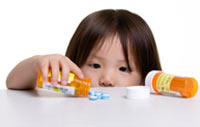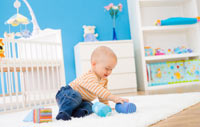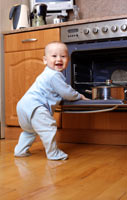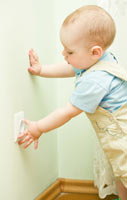Job Search
Tinies has hundreds of childcare jobs across the UK
Our Favourite Ways to Baby Proof Your Home
Bringing a baby home from the hospital is a time for new parents to be excited and wrapped up in their new family life, but it's also a time to think about how safe your home is for your child in the days, weeks, months and years to come
We all have odds and ends or gadgets lying around the house. Whether it's a pile of clothes on the stairs or a telephone cord acting as a trip wire, every home will have elements we think are safe that pose a risk to your baby's safety. For example, your flat screen TV may be your home cinema and pseudo football stadium, but what havock would ensure if it were to fall off the wall?
- Are your stairs a safe haven or a recipe for disaster?
- Can small hands reach your heated towel rails?
- And how secure are your bookshelves?
Remember - when children start to walk, they'll grab on to ANYTHING!
Baby proofing your home - simple fixes
 As there will always be something that sneaks through your inspection, baby proofing your home should not be a substitute for parental supervision.
As there will always be something that sneaks through your inspection, baby proofing your home should not be a substitute for parental supervision.
We asked the experts at Baby Safe Homes what you should be looking out for and how to implement some simple fixes.
If you'd like more specific advice for your own home, Baby Safe Homes offers a full consultation, recommendation and installation service to those living in London. If you live further afield, they are available for advice over the telephone.
When surveying your home, go through the house room by room and area by area. Don't forget all the nooks and crannies, and passageways. You will need to repeat this process and adjust these measures as your child gets older and taller!
Baby safety and tips for baby proofing
Babyproofing each room
Get down on your hands and knees and look around from your baby's perspective. This helps spot potentially dangerous objects. Even toddler toys left lying around by an older sibling should not be within the baby's reach.
 In every room, look at large items such as TVs, furniture, shelves, and wardrobes should be strapped to the wall with quality straps to reduce the possibility of tipping.
In every room, look at large items such as TVs, furniture, shelves, and wardrobes should be strapped to the wall with quality straps to reduce the possibility of tipping.
We have baby proofing tips and general baby safety advice for many different areas in your home:
Nursery
- Install blind cleats to keep blind cords out of reach of children
- Place some type of secondary Window Lock or Window Guard on each window
- Look for a changing table with straps that help prevent your baby from falling. Never turn your back or leave the baby unattended, even for the shortest moment. Just because your child hasn't demonstrated that they can roll over yet, it doesn't mean it's not the next trick they'll learn
- Install a Carbon Monoxide Sensor
- Pay special attention to electrical safety in the Nursery.
Cot safety
- Infants should always sleep in a cot that meets current safety standards; a cot deemed to have a safe design should come under European safety standards, so always make sure you look out for the BS EN 716
- Choose a firm mattress that is specifically designed for your cot. The cot mattress should fit snugly, with no more than two fingers width between the edge of the mattress and the cot
- Always use cot sheets that fit securely
- Cot bumper pads are not recommended by most paediatricians. If you choose to use cot bumper pads, make sure they fit around the entire cot and tie securely into place. Once the baby can pull up to a standing position, the bumper pads should be removed to reduce risk of the baby climbing out of their cot
- Remove sheepskins, pillow-like stuffed toys, and other pillow-like products from the cot. Many paediatricians discourage the use of any blankets or covers in the cot.
Kitchen
- Use back burners on stove to reduce risk of burns. If using front burners, always turn pot handles inward
- Medicines, bleaches, oven and drain cleaners, paint solvents, polishes, waxes, matches, cigarettes and lighters are dangerous and should always be kept out of reach
- Install stove shields and oven locks - where appropriate - to prevent little hands from burns
- Keep the dishwasher locked. If locking is not possible, point sharps downwards. Do not add dishwashing detergent until you plan to turn the dishwasher on
- Securely latch cabinets and drawers below counter level. Use quality latches designed for your specific cabinetry
- Ensure all cleaners, detergents and other chemicals and poisons are out of reach of children
- Make sure all alcohol is out of reach of children

- Keep knives and sharp objects toward the back of drawers
- When possible, keep rubbish bins out of the way
- Avoid using table cloths as they, and everything on them, can be pulled off the table in an instant
- Keep a fire extinguisher on hand in the kitchen.
Bathrooms
- Turn water heater temperature down to 55°C or less
- Never leave a child alone in the tub, even for a moment
- Install a tub mat in the bath tub to reduce head injuries and risk of slipping
- Install toilet locks
- Adjust water heater temperature to 55°C or less to help prevent scalding
- Keep razors, scissors, and medications high up and out of reach.
Bedrooms (other than the nursery)
- Remove prescription medications and any other hazardous objects from nightstands
- Ensure windows cannot be opened more than 10 cm
- Secure top-heavy furniture with quality furniture straps or L-brackets.
- Keep children out of closets.
Reception and living areas
- Turn water heater temperature down to 55°C or less
- Remove or block off tall floor lamps that could be pulled over
- Install blind cleats so cords are out of reach
- Pad sharp edges on tables and other furniture
- Install a hearth gate to keep children away from heat
- Ensure children don't have access to gas controls
- Remove glass-top coffee tables
- Keep plants away from children - some are poisonous, and leaves and dirt are choking hazards
- Bundle cords from phones, answering machines, computer equipment, and other small appliances with plastic wire ties and tie out of reach of small children. Lamp cords can be tied around or cable tied to a table leg
- Turn off power outlets when not in use
- If using socket protectors, ensure they are tight and can't be pried loose by children.
Window safety
- Check all windows and secure any dangling cords from blinds and curtains
- Install bolts or alternative locks to limit window openings to 10 cm
- Do not place furniture or beds near windows offering easy access for young children
- Do not leave your child unattended near open windows.
Utility room
- If possible, install a lock on the utility room door
- Keep as many of your cleaning products in the laundry room as possible stored in a locked cabinet
- Ensure the children do not have access to washing machines and dryers. Install locks on each if necessary.
Bannister, balcony, and terraces
- Balusters should be spaced no more than 10 cm apart
- Correct wide-spaces with additional rails, netting or plexiglas / banister shield. Extremely wide spacing may require some carpentry work
- Install safety gates to help prevent access to stairs
- Consider raising banister or railings with overall height lower than 90 cm
- Do not place chairs, benches, furniture, potted plants or any objects near banister or terrace railings as these can be used to climb over rails.
Baby gates

- Use quality safety gates to restrict your baby to a specific area or barricade them from a specific hazard
- Install a mounted safety gate at the top of every stairway
- For bottom of stairs, one of two methods is recommended. Create a Safe Zone by gating off an area to eliminate access to the bottom of the stairs. This method allows for closer adult supervision. If a Safe Zone is not an option, install a safety gate at the bottom of each stairway
- Some gates are not appropriate for use at the top of stairs, particularly pressure-mounted gates.
Speak to the experts at Baby Safe Homes for more information and baby proofing advice.
